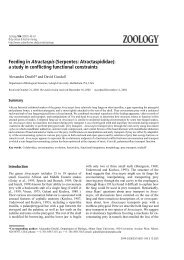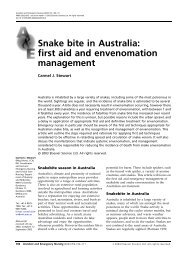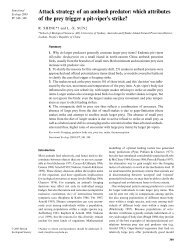Introduction - Kingsnake.com
Introduction - Kingsnake.com
Introduction - Kingsnake.com
You also want an ePaper? Increase the reach of your titles
YUMPU automatically turns print PDFs into web optimized ePapers that Google loves.
Clinical Management of Snakebite in Papua New Guinea Chapter 2<br />
In egg-laying (oviparous) species (such as all pythons and most venomous land species) the<br />
fertilized embryos develop in the female over a period of 6-10 weeks. At the end of this time<br />
the female will find a secluded location such as a deserted animal burrow, or the space under<br />
a large rock or log to use as a laying chamber. Pythons typically coil around their eggs to<br />
protect them from predators and to ensure an even incubation temperature. Female pythons do<br />
not feed while incubating eggs, however many use muscle contractions to generate slight<br />
increases in body heat to warm the eggs, and this added reproductive cost means that they<br />
may loose a considerable amount of body weight during this time.<br />
Most other egg-laying snakes deposit their eggs and then leave them to incubate at ambient<br />
temperature. Many ground-dwelling snakes lay their eggs in rotting vegetation in order to take<br />
advantage of higher temperatures due to de<strong>com</strong>position. These snakes are then able to resume<br />
feeding immediately, and many may subsequently produce additional clutches of eggs in the<br />
same year.<br />
The death adders (Acanthophis spp.) are unique among PNG’s venomous snakes in that they,<br />
like the marine sea snakes of the Family Hydrophiinae, produce live young (viviparous). The<br />
embryos develop inside the body of the female over a lengthy period (from 4 to 6 months in<br />
some species) before being born alive inside a thin membrane from which the young snakes<br />
rapidly break free and disperse. Once the baby snakes hatch, or are born, their parents have no<br />
interest in them, and adult snakes do not protect or guard their young – in fact many species<br />
will eat their own babies if the small snakes do not move away quickly.<br />
Life Expectancy<br />
There is very little information available about how long a snake can live in the wild. Snakes<br />
which are born and raised in captivity may live for more than 15-20 years; however this is not<br />
an accurate estimate of wild life expectancy because captive snakes do not have the same<br />
risks of predation or death through disease.<br />
What is known is that most juvenile snakes do not reach reproductive maturity until they are<br />
between 2 and 3 years of age. Reproduction is the driving force in all organisms and for a<br />
species to be successful it must reproduce at least once and have at least two juveniles survive<br />
long enough to reproduce themselves. The higher the risk to juveniles, the more young a<br />
snake is likely to produce in a single clutch or brood.<br />
Captive pythons have been known to live for more than 25 years, and some captive venomous<br />
snakes have also lived for between 15-20 years, although most live only for 8-10 years. With<br />
this in mind it is likely that the average life expectancy of most wild snakes would be from 5<br />
to 8 years depending on the species.<br />
Aggressive Behaviour<br />
It is very important to realise that snakes are not aggressive animals, although most will<br />
attempt to defend themselves if threatened or approached.<br />
All snakes are secretive. Their absence of limbs despite enabling them to adapt to many<br />
different environments does leave them with vulnerabilities, and most snakes spend the<br />
majority of their time being as elusive and secretive as possible in order to avoid potential<br />
predators. If a snake is given an opportunity to escape from a predator it will always take this<br />
option rather than attacking. At the same time however, different species may be more easily<br />
threatened than others; a death adder (Acanthophis spp.) has to be touched before it will bite,<br />
but a Papuan taipan (Oxyuranus scutellatus canni) may only need to be approached closely<br />
- 2.5 -










